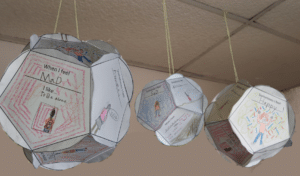School readiness doesn’t start in the summer before kindergarten. It actually begins at birth with a child’s entrance into the world where their brain will be shaped and developed by all people and experiences around them. Helping to grow a child’s brain may sound like a huge task, and it IS super important. Understanding how brains grow and develop can make it a little less intimidating.
Children all start out with millions of neurons. The developing brain is all about making connections between these neurons. Children’s interactions and experiences help to build connections between the neurons and organize networks. They also help the brain decide which connections to keep and which to prune-or take away.
So how can we encourage growth and development in our young children’s brains? Play with them, babble with them, see their experiences through their eyes and encourage them to interact with their interests. Here are 4 tips on nurturing growing brains in young children.
1.First, start with your child’s interest. Children’s brains develop through interactions with the people and the environment around them. One of the best ways to encourage brain growth is by paying attention to what children are interested in and nurturing this interest by providing more information and vocabulary, and encouraging kids to explore experiences, objects, and the world around them.
2. Provide labels and names for objects, actions, feelings, and experiences. Notice where your child’s attention is, and provide a name or label for their interest.
- For very young children and babies, notice where they are looking, or what they are crawling towards, or grasping for, and provide simple labels or names for things in their environment, or their actions. “That’s a book” or “You’re crawling to the blocks.”
- For older children, include naming feelings and experiences, using more complex labeling and vocabulary. “Your face looks like you are frustrated; that jungle puzzle is difficult. Can you find all the puzzle pieces that have a flat side like this to start with?”
3. Ask questions. Encourage your child to expand on their interests by asking them questions to prompt them to think differently, or more deeply, about what they are doing or interested in.
- Try asking questions that prompt kids to make connections: Why do you think she did that? What do you think he will do next? How are you going to do that? How do you think they felt when that happened? What will you try next?
4. Encourage turn taking in speech and behavior. One of the ways caregivers can help wire children’s brains is to encourage turn taking behavior that is based on responding to children’s bids for interaction.
- Instead of prompting children to do something, pay attention to what they do and where their attention goes, then respond, and watch how they respond back. When your child points and says, “Ball!” you might respond, “Yes, that’s a basketball”, then wait for them to respond, and continue this back and forth, turn taking behavior based on where their interest takes you. These kinds of interactions build children’s brain development for communication and social interactions.
Growing young children’s brains is so important to children’s future development and success in life. The good news is, what they need from you doesn’t cost money, and doesn’t require specialized training or newfangled tools; all they need is your time and attention. They don’t need you to set aside hours either. All those minutes you spend throughout your day noticing what they are interested in and encouraging them to explore and learn more about their world can build into a growing and thriving brain.
[divider type=”standard” text=”Go to top” full_width=”no” width=”1/1″ el_position=”first last”]
Text: © Kids In Transition to School 2020
Image: © Oksun70 | Dreamstime.com





